
Obsidian and Notion are both apps that can be used to create and organize notes and wikis, but they each take a fundamentally different approach to this task. In this guide, we will compare and contrast Obsidian and Notion to help you figure out which one is best for your needs.
Jump to:
Obsidian is a note-taking app that stores files locally on your devices instead of in the cloud, so you must download an app in order to use Obsidian. Obsidian uses Markdown files and language to create and format your notes, and it uses a knowledge graph structure to connect notes through bi-directional thinking, vs. a more traditional and hierarchical database structure.
Notion is a cloud-based productivity app that lets you track projects and create and organize notes. It can be accessed via web browser, desktop apps for Windows and Mac or mobile apps for iOS and Android. A Notion widget is available for both iPhone and Android, so you can access it right from your home screen.
| Features | Obsidian | Notion |
|---|---|---|
| Linked thinking visualization | Yes | No |
| Free syncing and publishing | No | Yes |
| Project management features | No | Yes |
| Team collaboration | No | Yes |
| Automated import | No | Yes |
Obsidian follows a somewhat unusual pricing scheme. If you just want to download the app for personal use on a single device, it is free to use forever: no file upload limits, no limits on the number of notes you can have, nothing. If you want to use Obsidian for work, it costs $50 per user per year to get the commercial license. You get a 14-day trial before you pay, and this tier comes with priority support.
The catch is that you have to pay extra if you want to sync between devices or publish your Obsidian pages to the web. It costs $8 per person per month billed annually for Obsidian Sync, and another $8 per month per site billed annually for Obsidian Publish. Since most note-taking services offer free syncing and publishing for all accounts, this is a bit of a drawback. While Obsidian may appear more cost-effective at first glance, these additional fees can quickly add up.
There is also the option for all users to pay a one-time $25 fee for Obsidian Catalyst, which gets you early access to the beta version and the VIP channel, as well as special community badges. The Obsidian Catalyst is a way to keep Obsidian’s development 100% user-supported.
Notion offers four pricing tiers and does not charge extra for syncing or publishing functionality. The four pricing tiers offered by Notion are:
You can also choose to add the optional Notion AI to any paid plan for $8 per user per month, billed annually. Notion AI can be used to generate summaries, rewrite documents and brainstorm ideas.
You can request a trial of the Business plan and a demo or a trial of the Enterprise plan, but you’ll need to contact the sales team to do both — you can’t sign up for either directly. For more information, read our full Notion review. You can also see how Notion stacks up in our comparison of Notion vs. Asana, Notion vs. Trello, Coda vs. Notion and ClickUp vs. Notion.
Both Obsidian and Notion can be used to create personal notes and wikis for either personal or team use. In addition to creating text, you can add pictures, videos and links to make your notes more interactive.
Obsidian takes a slightly different approach since it is designed to be used as a second brain, a.k.a. a searchable repository of an individual’s thoughts and knowledge. You categorize each note with different hashtags and then explore the many different ways they are linked together with the open graph view (Figure A, Obsidian apps). You can view multiple notes at a time using a split window and format the content visually with the Canvas feature. Obsidian uses Markdown to create and format notes, which can be a learning curve if you are not already familiar with it.
Figure A
Notion does not offer this kind of interconnected organization, so if that is essential for you, Obsidian is a better pick. Notion takes a more traditional database approach to organizing notes and pages in a hierarchical structure (Figure B, Notion notes list), which will be familiar to people who have used other note-taking apps. Notion does not require markdown knowledge in order to create and format notes using the includes toolbar, presenting a lower learning curve and making it much more user-friendly. If you’re not committed to building a second brain with bi-directional thinking connection, and just want to keep track of your notes, Notion will probably be a better fit for your needs.
Figure B
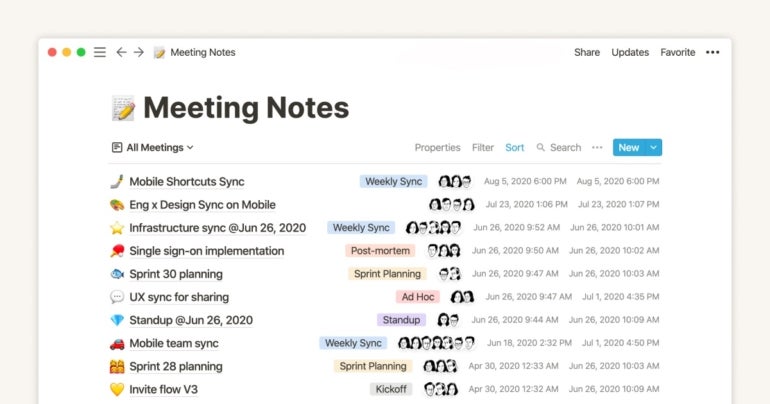
Obsidian does not offer any native project management features. However, the extensive library of more than 1,000 plug-ins (Figure C) does allow you to add certain project management functionality, such as Kanban boards and time tracking. That being said, it will take a lot of plug-ins and tinkering around to get Obsidian anywhere close to the level of functionality of a dedicated project management app, since that’s not what it’s meant for. If you need a project management solution, it will be easier to choose a platform that is designed for that.
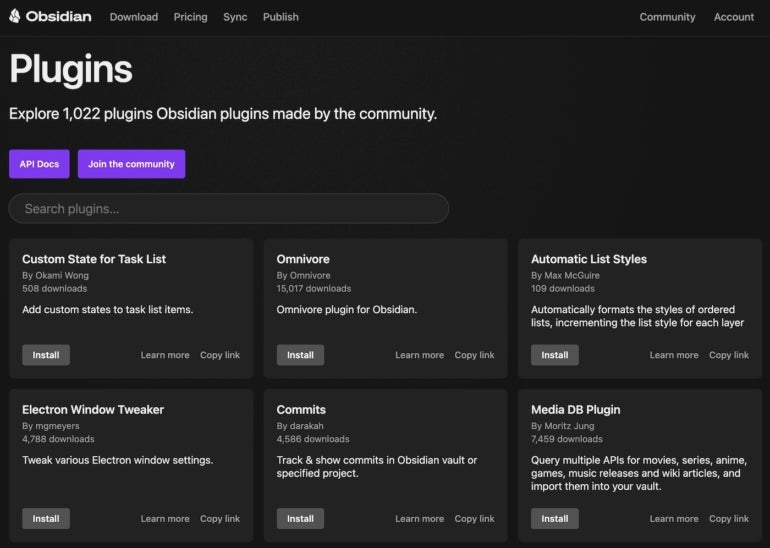
Notion does offer a good selection of project management features (Figure D) paired with a low learning curve, which is why it made our lists for both the best project management software for startups and the best project management software for freelancers. You can assign tasks to yourself or other people, set deadlines and choose from multiple project views such as Kanban boards Gantt charts (called timelines). However, Notion is not as robust as other project management solutions like monday work management, and it lacks certain native features such as time tracking. This means that it isn’t the best choice for power users who need a lot of project management features.
Figure D
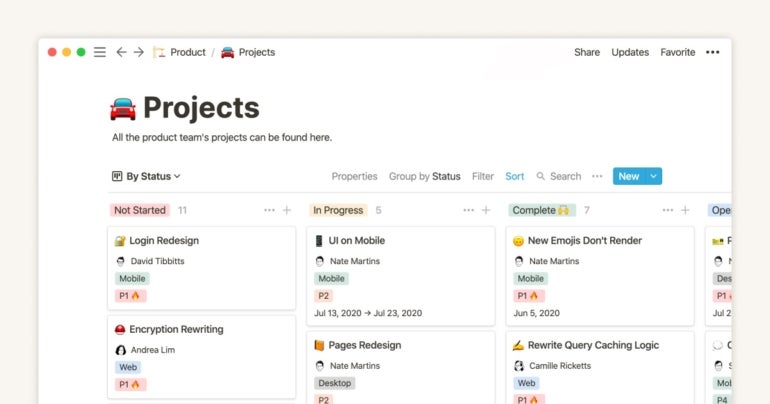
Obsidian was designed for personal note-taking first and foremost, and that shows up in the lack of collaboration features. If you pay for the sync version, you can share your file vault with other people so they can edit it (Figure E). But in order to leave comments you have to use Markdown language, so the comments don’t function the same way they do in other tools. You also can’t summon someone else with an @ mention. If you need these kinds of collaboration features, Obsidian is not a good fit for your needs.
Figure E
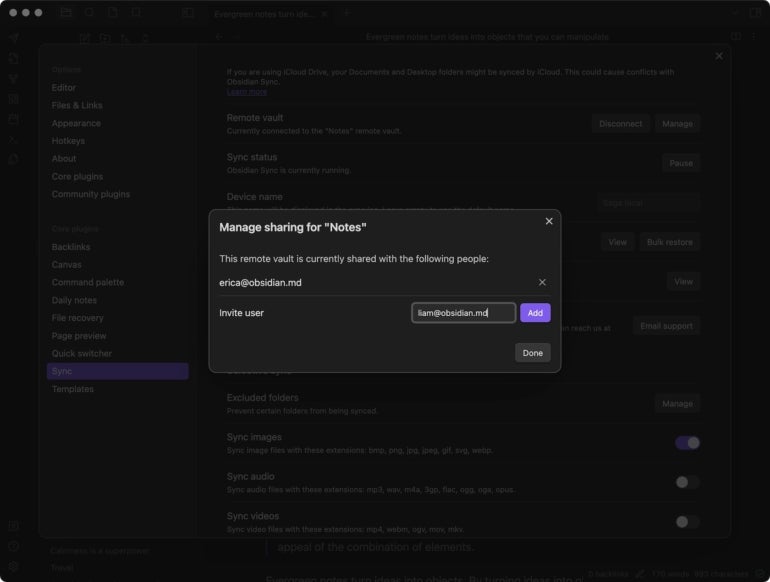
On the flip side, Notion allows you to comment on items (Figure F), tag colleagues in messages, reply to comments directly within the tool and react to comments with emojis to acknowledge them. It doesn’t offer direct messages like Asana or a native video chat option like Teamwork, so you’ll need to move to a different software like Slack or Zoom if you want to have an extended discussion. That being said, Notion does offer way more sharing and collaboration features than Obsidian, so it’s a better choice if you are looking for a tool you can use with teammates.
Figure F
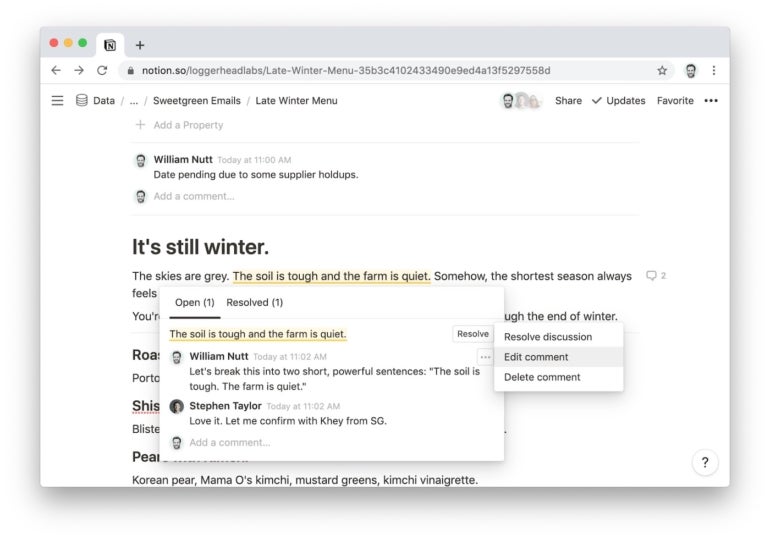
Normally we don’t include importing in our comparisons because most productivity platforms improve built-in tools that automate importing your notes and files from another service. The idea is to make switching platforms as painless as possible, so it’s not an impediment to users. However, Obsidian requires you to manually export your notes as Markdown files (.md) and then upload them into the tool, which can be time-consuming and tedious if you’re not familiar with the process already.
Meanwhile, Notion lets you upload five different file types: plaintext (.txt), markdown (.md or .markdown), Microsoft Word (.docx), CSV (.csv) and HTML (.html). It also offers import tools for a number of other apps, including Confluence, Asana, Evernote and Trello (Figure G). As such, it’s much easier to switch to Notion from another service regardless of how you currently take notes.
Figure G
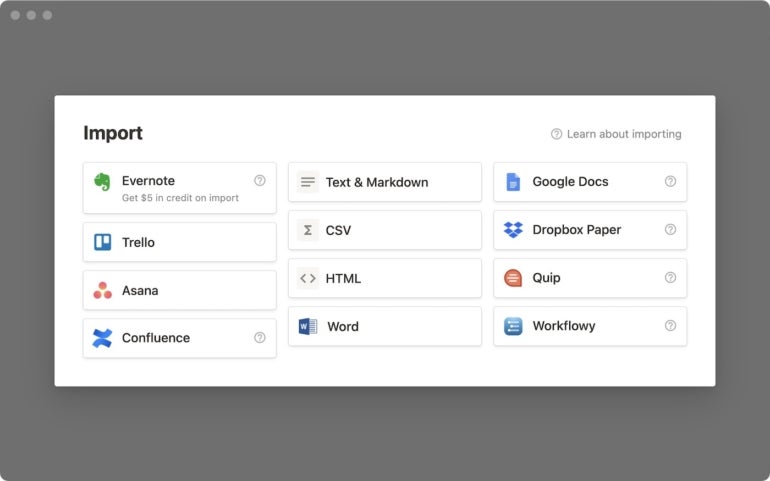
To compare Obsidian and Notion, we signed up for free accounts and consulted demo videos, product documentation, user reviews and community resource forums. We considered factors such as pricing, interface design, ease of use and importing, as well as features such as project management, team collaboration and note organization.
While they may seem like similar note-taking apps at first glance, Obsidian and Notion were actually designed with two completely different end users in mind. Obsidian is meant to act like your “second brain,” becoming an entire repository of notes for a single individual. This is why it includes features like open graph visualization but lacks team collaboration and project management functionality. The desktop app offers full functionality for free, but you’ll have to pay if you want to sync across devices or publish to the web, which means that Obsidian can quickly become more expensive than competitors.
On the other hand, Notion is better suited for those who want to create and share notes and wikis with teammates. It also offers way more project management features and templates than Obsidian does, though it falls short of more robust PM tools such as monday work management. This combination of notes and project management makes Notion especially well-suited for content creators, marketing departments and other teams that work largely with text. You could also conceivably use Obsidian and Notion together, making your personal notes in Obsidian while using Notion for team collaboration and project management.
monday.com Work OS is the project management software that helps you and your team plan, execute, and track projects and workflows in one collaborative space. Manage everything from simple to complex projects more efficiently with the help of visual boards, 200+ ready-made templates, clever no-code automations, and easy integrations. In addition, custom dashboards simplify reporting, so you can evaluate your progress and make data-driven decisions.
Tackle complex projects with Wrike’s award-winning project management software. Break projects into simple steps, assign tasks to team members, and visualize progress with Gantt charts, Kanban boards, and calendars. Manage resource allocation and forecasting with software that’s easy to launch. Automation and AI features strip away time-consuming admin tasks so you can do the best work of your life. Streamline your practices, align your team, and ensure you hit deadlines and stay on budget.
Smartsheet is an online work execution platform empowering organizations of all sizes to plan, manage, automate, and report on work. Over 80,000 brands rely on Smartsheet for project and work management.
#1 rated with 20 years of real-world use, Workzone offers a suite of carefully chosen features, making it easy for everyone to use. Looking for lasting process change? Difficulty adopting a tool before? Get unlimited support from experienced trainers who will help you create systems & manage projects successfully for years to come. Starting at $200/month for a team of 5. Access the features you need (without the fluff), including collaboration, creative review, resource management, & reporting.
BigTime is a leading Professional Services Automation (PSA) software that helps you scale your business by giving you the ability to track and act on your operational metrics. Even with remote work, easily manage time, expenses, and billing for multiple projects all at once, and quickly identify areas of opportunity with advanced features like resource allocation and custom reporting. With BigTime Wallet and client portal, you can get paid faster using custom invoicing and payment processing.